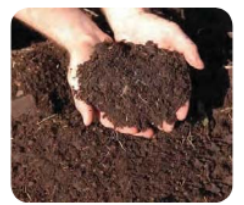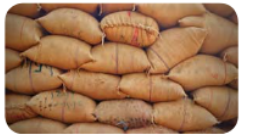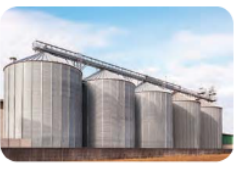KSEEB Solutions For Class 8 Biology Chapter 10 Food Production Notes
We obtain food from plants in the form of vegetables, cereals, pulses, fruits, etc., which are grown in fields by farmers. Farming is the primary occupation of a large number of people around the world especially in India. It is primarily the source of food and then the source of income for most of the people.
Agriculture
Agriculture is a broad term used for of all the farm related activities such as cultivation of plants, producing food and cash crops, domestication of animals, fisheries, horticulture and much more. It is the prime factor of India’s growth and provides employment to a large number of people. In fact, agriculture is the primary source of living for the people living in rural areas of India.
Agriculture is not only important for growing food but also other products such as fuels, fibres and other raw materials such as wool, silk, resins, biofuels, bamboos, etc.
When the same kind of plants are grown in the fields on a large scale to obtain foods like cereals (wheat, rice, maize), pulses, vegetables and fruits, etc., it is called a crop. Crops are grown in the fields by farmers (kissan). Some of the examples of crops are given below:
- Cereal crops: Wheat, Paddy (Rice), Maize, Millet (Bajra, Jawar), Barley (Grain crops)
- Pulses: Gram (Cham), Peas, Beans
- Oil seeds: Mustard, Groundnut, Sunflower
- Vegetables: Tomato, Cabbage, Spinach
- Fruits: Banana, Grapes, Guava, Mango, Orange, Apple
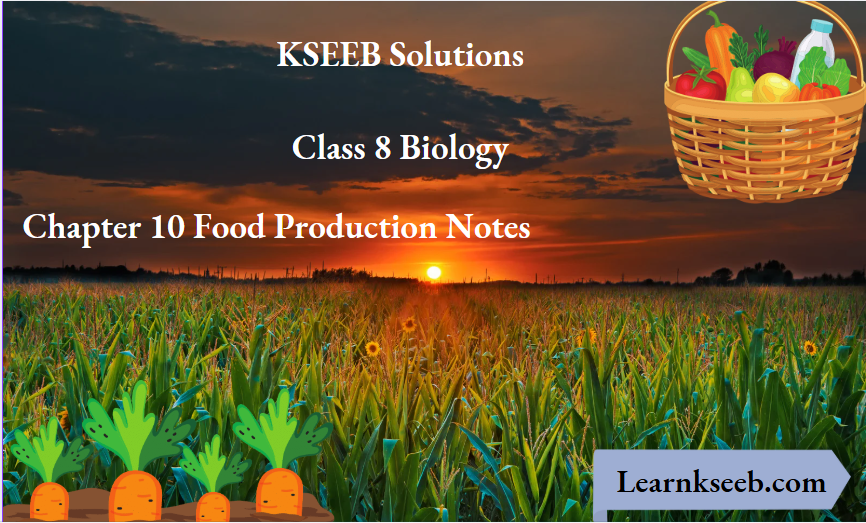
Kseeb Class 8 Biology Chapter 10 Food Production Solutions Pdf
Crops Based On Growing Season
Based on the seasons (in which they grow well), all the crops are categorised into two main groups: Kharif crops, and Rabi crops.
Kharif Crops
The crops which arc sown in the rainy season are called kharif crops. The sowing for kharif crops starts in June-July at the beginning of southwest monsoon because these crops (particularly paddy) need substantial amount of water. The kharif crops are harvested at the end of monsoon season during September (or October). Some of the examples of kharif crops are: paddy, maize, millet, soyabean, groundnut and cotton. The kharif crops are sometimes also called ‘summer crops’.

Sslc Class 8 Biology Food Production Question And Answers
Rabi Crops
The crops grown in the winter season arc called rabi crops. The time period of rabi crops is generally from October to March. The sowing for rabi crops begins at the beginning of winter (October-November) and the crops are harvested by March (or April). Some of the examples of rabi crops are: wheat, gram (chana), peas, mustard, and linseed.
Kseeb Class 8 Biology Food Production Textbook Solutions
Crops On The Basis Of Their Lifespan
On the basis of lifespan, the crops can be categorised as—annual crops, biennial crops and perennial crops.
Annual Crops
Annual crops are the ones which complete their lifecycle in one year or in one growing season. In other words, if an annual crop is sown at a particular period of time, then it grows and is harvested within a span of one year. The vegetative and reproductive stages of annual crops get completed on an annual basis.
This means that the year in which they are grown, they produce fruits in the same year only. Some of the examples of annual crops are rice, millet, maize, cotton and groundnut.
Food Production Class 8 Biology Kseeb Important Questions
Biennial Crops
Biennial crops are those crops which complete their lifecycle in two years or in two growing seasons. In other words, if a biennial crop is sown at a particular period of time, then it grows and is harvested within a span of two years. That is, they are grown in the first year in which the roots and leaves are produced, then in the second year they produce flower, fruits and seeds. Some of the examples of biennial crops are carrot, ginger, cabbage, etc.
Perennial Crops
Perennial crops are the crops that can survive without replanting for several years, which means they can be harvested several times before replanting is needed. If a perennial crop is sown at a particular period of time, then it re-grows after harvest. Perennial fruit crops are less labour-intensive and have a relatively long lifespan. They produce food for many years after a single planting as compared to annual plants that need to be regrown every year.
Some of the examples of perennial crops are sugar cane, banana, etc. Any crop that survives and grows above the span of three years are called permanent crops such as mango, coconut, etc.
Crops On The Basis Of Purpose Of Cultivation
Crops further have been divided on the basis of purpose of their cultivation into the following two types:
Food Crops
Crops which arc grown for obtaining food are called food crops. Pulses, cereals, fruits and vegetables are some examples of food crops.
Cash Crops
Crops which are grown to earn profit or cash are called cash crops. Cotton, sugar cane, lea, rubber, spices and coffee are some examples of cash crops.
Horticulture
Horticulture is the branch of agriculture which focuses on growing plants, vegetables and decorative flowers and plants. Besides these, horticulture also includes plant conservation, landscape design, garden design and maintenance. Horticulture also helps farmers to make orchards. Orchards are areas where fruits, vegetables and nut-producing trees are grown for obtaining profit or as cash crops. Horticulture crops include:
Vegetables: Such as beans, spinach, tomato, etc.
Fruits: Such as banana, apple, grapes, papaya, cherry, citrus fruits, peach, plums, nuts almonds, pomegranates etc.
Decorative or Ornamental plants: Plants and flowers such as crotons, ferns, rose, jasmine, etc.
Spices: Such as cloves, chilli, black pepper, turmeric, ginger, bay leaf, etc.
Karnataka Sslc Class 8 Biology Chapter 10 Solutions In English
Cultivation Of Horticulture Crops
Several artificial methods have been developed to promote vegetative propagation by horticulturists. The artificial methods of vegetative propagation include cutting, layering, grafting and tissue culture.
Cutting
The method of cutting the stem into small pieces and planting the cut end in soil is known as cutting. The piece of stem eventually bears roots and new leaves which grows into an adult plant. Examples of plants where the artificial vegetative propagation is carried out by means of cutting are money plant, rose and China rose.
Layering
In this method, a portion of the aerial stem is made to grow roots while it is still attached to the parent plant and later is detached from it, so that it grows into an independent plant. In this method, a part of the lower branch of the plant is bent down, so that it touches the soil and a layer of bark is removed from the place where it touches the soil. Layering is carried out in plants such as climbing rose, mint and raspberries.
Grafting
In this method, a small part of the stem or a bud is fixed or attached to the stem of another plant of the same species or related species. When a portion of a cut stem is grafted onto another stem, the cut stem is fixed properly and covered with tape, so that it becomes part of the host plant and continues to grow. The stem of the host plant is known as the stock, while the cut stem that is added to it is known as the scion.
Grafting is usually done on a plant that is growing well, is sturdy and free from diseases. The grafted stem is usually added for more flowers and fruits as good qualities of both the plants are combined in the host plant. Grafting is most commonly seen in rose plants.
Organic Farming
Organic farming is a method of farming in which a land is cultivated and crops are grown with an aim to maintain the fertility of the soil by using organic wastes from plants and animals. In this approach of farming, har mful chemicals, such as, fertilizers, herbicides and pesticides are either not used at all or are used in minimum amounts. The concept was introduced by Sir Albert Howard, who is recognised as the Father of Organic Farming.
Due to the harmful effects of using chemical fertilizers, pesticides and weedicides, the farmers and horticulturists are shifting to organic farming, as it is an eco-friendly method of crop cultivation. Farmers use organic manures to raise the crops. Organic wastes (like waste of plants and animals) and biological materials along with beneficial microbes are mixed together to make the manure.
Combination of crop rotation, green manure, compost, biological pest control hand weeding, mixed weeding are some other techniques used by the farmers to improve soil fertility in organic farming.
Organic farming helps in the following ways:
- It helps in protecting the fertility of soil for a longer period of time by:
- Maintaining the level of nutrients in the soil
- Encouraging the biological activity in the soil
- Making sure that the mechanical intervention is done carefully
- It helps in maintaining the nitrogen level of the soil by the use of legumes and biological nitrogen fixation and also helps in the recycling of organic materials including crop wastes and livestock manures effectively.
- It helps in protecting the crops from weeds, pests, and diseases through crop rotations, natural predators, organic manuring, resistant varieties and limited thermal, biological and chemical intervention.
- It also helps in conserving the environment and natural habitats of wildlife by reducing the negative impact of farming system
on them.
Kseeb Class 8 Biology Food Production Solved Exercises
Green Revolution
The green revolution is defined as a period when the productivity of global agriculture increased drastically as a result of new advances. The period of Green Revolution started in India around the year 1967-68 when the agricultural practices were improved by using improved and advanced technology. It mainly took place in Punjab, Haryana and Uttar Pradesh which later spread to other states.
Eminent Scientists such as Dr Norman Borlaug (America) and M.S. Swaminathan contributed in the development of high-yielding varieties of wheat and rice. During this period, fertilizers and pesticides were also developed to sustain the growth of crops and crop yields. The spread and adoption of modern technologies in the agriculture, made India produce more grains. This not only made India a self-sufficient country, but also established it as one of the world’s major agriculture producers.
Agricultural Practices
In order to raise a crop (or cultivate a crop) successfully and profitably for food production, a farmer has to perform a large number of tasks in a sequence (one after the other). The various tasks performed by a farmer to produce a good crop are called agricultural practices. The various agricultural practices which are carried out at various stages of crop production are:
- Preparing soil
- Seed selection
- Sowing
- Irrigation
- Manuring and fertilising
- Crop protection
- Harvesting
- Storage of grains
Let us understand these activities one by one.
Preparing The Soil
Preparation of soil is the first step in cultivating a crop for food production. The soil is prepared for sowing the seeds of the crop by (/) ploughing, (it) levelling, and (iii) manuring. Each one of these steps has its own significance. This is described below. The process of loosening and turning the soil is called ploughing (or tilling). Ploughing (or tilling) of fields is done by using an implement called plough.
Ploughs are made of wood or iron, and they have an iron tip for easy penetration into the soil. The ploughs are pulled by a pair of bullocks or by a tractor. Actually, the ploughing of small fields is done with the help of animals like bullocks while large fields are ploughed by using tractors. The loosening of soil by ploughing is beneficial because of the following reasons:
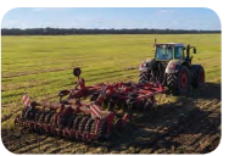 The loose soil allows the plant roots to penetrate freely and deeper into the soil so that plants are held more firmly to the ground.
The loose soil allows the plant roots to penetrate freely and deeper into the soil so that plants are held more firmly to the ground.- The loose soil allows the roots of the plants to breathe easily (even when the roots are deep). This is because loose soil can hold a lot of air in its spaces.
- The loose soil helps in the growth of worms and microbes present in the soil who arc friends of the farmer since they help in further turning and loosening the soil. They also add humus to the soil.
- Ploughing also uproots and buries the weeds (unwanted plants) standing in the field and thereby suffocates them to death.
- The loosening and turning of soil during ploughing brings the nutrient rich soil to the top so that the plants can use these nutrients.
The ploughed soil is levelled by pressing it with a wooden leveller (or an iron leveller) so that the top soil is not blown away by wind or drained off by water (and soil erosion is prevented). ‘Manuring’ means ‘adding manure to the soil’. Sometimes, manure is added to the soil before ploughing. Addition of manure to soil before ploughing helps in the proper mixing of manure with the soil.
Manure is first transported to the fields. It is then spread out in the fields. When this field is ploughed, the manure gets mixed in the soil properly. Manure contains many nutrients required for the growth of crop plants. So, manuring is done to increase the fertility of the soil before seeds arc sown into it.
Seed Selection
Before sowing, good quality seeds are selected. Good quality seeds are clean and healthy seeds, free from infection and diseases. Farmers prefer to use seeds which give high yield of food grains.
Class 8 Biology Food Production Notes Karnataka Board
Sowing
Seeds are sown in the soil either by hand or by-seed drill. Thus, there are two methods of sowing the seeds in the soil. These are:
- Sowing by hand, and
- Sowing with a seed drill.
The sowing of seeds by hand (or manually) is called broadcasting. In the sowing with hand or manually, the seeds are taken in hand and gradually scattered in the entire ploughed field. This method is, however, not very good because there is no proper spacing or proper depth at which the seeds are sown by hand. Moreover, the seeds scattered on the surface of the soil for sowing can be picked up and eaten by the birds. The implement used for sowing is a seed drill.
A seed drill is a long iron tube having a funnel at the top. The seed drill is tied to the back of the plough and seeds are put into the funnel of the seed drill. And as the plough makes furrows in the soil, the seeds from the seed drill are gradually released and sown into the soil furrows made by the plough. Thus, by using a seed drill for sowing, the seeds are sown at the correct depth and correct intervals (or spacings).
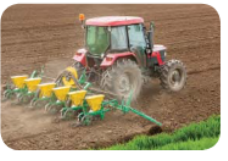
The seeds sown with a seed drill are in regular rows. Moreover, when the seeds are sown in furrows by a seed-drill, the seeds get covered by soil. Due to this, these seeds cannot be picked up and eaten by the birds. It is obvious that the sowing with seed-drill is much better than sowing by hand.
Irrigation
The process of supplying water to crop plants in the fields is called irrigation. Just as we cannot survive without water for a long time, in the same way, plants also cannot survive without water for a long time. For example, if we stop watering plants grown in our home for a considerable time, the plants become pale, wilt and ultimately die. Water is absorbed by the roots of the plants. Along with water, minerals and fertilisers are also absorbed by crop plants. Plants contain nearly 90 per cent water. Crops are supplied water for irrigation from different sources like: rivers, canals, wells, tube-wells, dams (reservoirs), ponds and lakes. Even rain is a source of irrigation of crops. The water available in wells, lakes and canals is lifted up by different methods in different regions for taking it to the fields.
Methods Of Irrigation
The various traditional methods of irrigation are: Moat (Pulley system), Chain pump, Dhekli, and Rabat (Lever system).
Moat: In the moat system of irrigation, water is drawn out from a well by using a big container tied to a long rope which moves over a pulley fixed at one edge of the well. The rope tied to the container is usually pulled by animals such as bullock (buffalo or camel). When the rope is pulled at the free end, the container filled with water (tied at the other end of the rope) comes out of the well.
Chain pump: Chain pump is an arrangement to lift water from a source of water like a stream, pond or lake (which is at a lower level than the fields) so as to provide irrigation in the fields.
Dhekli: Dhekli is an arrangement to lift water from shallow wells by using the principle of simple lever (The word ‘dhekli’ means ‘lever- beam of welF). In dhekli, a long wooden beam is supported over a forked vertical support fixed in the ground near the well in such a way that its longer arm is towards the well and shorter arm away from it.
Rabat (lever system): In the rahat system of irrigation, water is drawn out from a well. In this method, there is a large wheel fixed on an axle above the mouth of the well. A long belt with many, many small metal pots is put over the circumference of the big wheel wrhich can move over the wheel when the wheel turns. The lower end of the long belt of pots dips in the water of the well.
Food Production Class 8 Biology Summary And Explanation Kseeb
When the wheel rotates, the water filled pots come out of the well one after the other, go over the wheel, come downward, pour water in a channel, get emptied and then go down again into the well to bring out more water. The modern methods of irrigation help us to use water economically (by preventing its wastage). The two main modern methods of irrigation are: Sprinkler system, and Drip system. In the sprinkler system of irrigation, a main pipeline is laid in the fields.
Perpendicular pipes having rotating nozzles at the lop are joined to the main pipeline at regular intervals. When water from a tube-well is allowed to flow through the main pipeline under pressure with the help of a pump, it escapes from the rotating nozzles. This water gets sprinkled on the crop plants as if it is raining. In the drip irrigation system, there is a network of narrow pipes (or tubes) with small holes, in ihe fields.
When water flows through the narrow pipes, it falls drop by drop at the position of roots of the plants. This water is absorbed by the soil in the root zone of the plants and utilised by the plants.

Manuring And Fertilisation
‘Manuring’ means ‘adding manure to the soil’. The crop plants need a number of mineral elements for their growth which they get from the soil through their roots. Now, repeated growing of crops in the same field removes a lot of precious mineral elements, organic matter and other materials from the soil.
Due to this the soil becomes infertile after some time, and the crop yield decreases. So, unless the depleted plant nutrients are put back into the soil from time to time, the growth of crop would be poor. The deficiency of plant nutrients and organic matter in the soil is made up by adding manures and fertilisers to the soil.
Free KSEEB Notes For Class 8 Food Production
Manure
A manure is a natural substance obtained by the decomposition of animal wastes like cow-dung, human wastes, and plant residues, which supplies Manure used essential elements m fields and humus to the soil and makes it more fertile. Manures contain a mixture of various nutrient elements and a lot of organic matter (humus) recycled from bio-mass wastes (animal and plant wastes).
Though manures are not very rich in plant nutrients like nitrogen, phosphorus and potassium, but they are rich in organic chemical nutrients like humus. A manure is, however, very bulky and voluminous due to which it is inconvenient to store and transport. Moreover, a manure is not “nutrient specific”, and hence it is not much helpful when a particular nutrient is required in the soil for a particular crop. A chemical fertiliser, on the other hand, is nutrient specific.
Sslc Class 8 Biology Chapter 10 Workbook Answers
Fertilisers
Fertilizers are natural or synthetic (chemical) substances that are added to the soil. A chemical fertiliser is a salt or an organic compound containing the necessary plant nutrients like nitrogen, phosphorus or potassium, to make the soil more fertile. The chemical fertilisers are nutrient specific.
This means that a chemical fertiliser can provide only nitrogen, only phosphorus or only potassium to the soil, as required. The chemical fertilisers have plant nutrients in a concentrated form. So, they provide quick replenishment of plant nutrients in the soil and restore its fertility. The chemical fertilisers can be applied before sowing, during irrigation or sprayed on standing crops. The use of fertilisers has helped the farmers to get better yield of crops such as wheal, paddy (rice) and maize, etc.
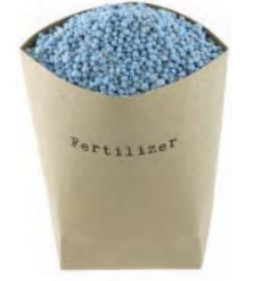
Activity-1
Aim: To make compost in the school garden
Procedure: Select an apt area in your school garden where you can make compost. Take a pit and place it at a place where it won’t disturb other people. Spread the litter of farm animals at the base. Prepare a mixture of vegetable scrapings, fruit peelings, seeds, tea bags etc. Fill the pit with the mixture. Cover the pit with mud and leave the set up for 4-5 months.
Observation: On digging the heap, you will find a dark substance rich in manure.
Skills: Environmental awareness, Observation, Interpretation
Activity-2
Aim: Making manure by setting up a vermin-composite in the school garden The process of decomposing organic food waste into a nutrient-rich material with the help of earthworms is called vermicomposting.
Material required: Vegetable and fruit peelings, cowdung, earthworms
Method: Select a suitable area in your school garden. Dig a 2 meter long. 1 metre wide and 1 metre long pit. Lay a mixture of hay, cowdung, vegetable and fruit peelings, etc in it. The materials should be laid in layers one after the other. Moisten each layer by sprinkling some water over it. Introduce some earthworms in the pit after the task of forming layers. Cover the pit with mud. Leave the set-up for a 15-20 days.
Observations: You will find a brown black layer at the bottom of the bin. This material is compost. You can use it to spread in your garden to improve the soil fertility.
Protection Of Crop Plants
We know that plants and crops are exposed to many factors such as birds, insects, rodents, weeds, etc. Therefore, it is necessary to protect and save the plants from getting damaged by these factors through crop protection. Crop protection involves the methods which are used to protect the crops and plants. It includes removing insects, pests and weeds that grow on the plants overtime.
Thus, for saving plants, protection methods such as spraying pesticides, undertaking pest control or bird scarers (scare-crows) are used to keep the insects and other animals or birds away from the crops.
Harvesting
The cutting and gathering of the matured food crop is called harvesting. In harvesting, the crops like wheat or rice are cut close to the ground by hand using a cutting tool called sickle. This is called manual harvesting. In large fields, wheat and paddy crops arc cut by a motorised machine called harvester.
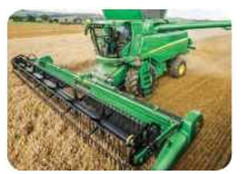
Threshing
After harvesting the crop, the next step is threshing. The process of beati ng out the grains from the harvested crop plants is called threshing.
Karnataka Board Class 8 Biology Food Production Agricultural Practices Notes
Winnowing
Though the process of threshing brings out grains from the cut and dried crop plants, but this grain is mixed with chaff (outer inedible covering of grain) and hay, and has to be cleaned by separating from chaff and hay, before it can be used. This is done by the process of winnowing. The process of separating grain from chaff and hay with the help of wind is called winnowing.
These days ‘combines’ (also called combine harvesters) are being used in large farms for harvesting related operations. A combine is a huge machine which cuts the standing cereal crop (like wheat) in the fields, threshes it and separates the chaff from grain in one operation.
Storage Of Grains
The fresh food grains (like wheat) obtained by the harvesting of crops contain more moisture than required for their safe storage. So, the food grains (like wheal) obtained by harvesting the crops are dried in die sunshine before storing, to reduce their moisture. The large scale storage of food grains (like wheat and rice) is done in two ways: in gunny bags, and in grain silos.
Crop Improvement Methods
Hybridization
By using the plant breeding techniques, the plant breeders develop new varieties which are more resistant to diseases and pests and give higher yield with early maturing quality.
The process of cross-breeding of different plants to obtain a new improved variety of crop is called hybridization. The breeding method which uses the variation created by mutagenesis is called mutation breeding.
In this method, gamma rays and X-rays are used as the mutagens which produces the required physical mutation in the plants. On the other hand, ethyl methane sulphonate, ethylene imine and sodium azide are used as the mutagens which produces the required chemical mutation in the plants. JRO 3690 (Jute), Sharbati Sonora, (Wheat), Jagannath (Rice), Co8152 (sugarcane) are some of the varieties produced through mutation breeding in India.
Class 8 Kseeb Biology Food Production Methods And Techniques
Genetic Engineering
Introduction and expression of foreign DNA in plants and animals is called genetic engineering. In this process, a gene is introduced in a plant by the technique of recombinant DNA technology and genetic transformation. It helps in improving specific traits of a plant.
Keywords
- Agriculture: Cultivation of animals, plants or any other life forms to derive food, fibre, and other products which are required to sustain life
Manures: The organic matter and minerals that are added to the soil for its enrichment - Fertilisers: Natural or synthetic substances that are added to the soil to provide necessary nutrients to it
- Harvesting: The cutting and gathering of the matured food crop
- Irrigation: The process of supplying water to crop plants in the field
Organic farming: Kind of farming practice in which harmful chemicals (fertilisers, herbicide, and pesticide) are either not used at all or are used in minimum amounts.
Pest: Any destructive organism which destroy crops
Annual crops: The crops which complete their life cycle in one year or in one growing season - Biennial crops: The crops which complete their life cycle in two years or in two growing seasons
- Perennial crops: The crops which complete their life cycle in three years or in three growing seasons
Summary
- Agriculture is a broad term used for all the farm related activities such as cultivation of plants, producing food and cash crops, domestication cf animals, horticulture and much more.
- Based on the Indian seasons, the crops are mainly divided into two types—kharif crops and rabi crops
- On the basis of lifespan, the crops can be categorised as—annuals, biennials and perennials
- Cash crops are the ones that are basically grown for selling on profits rather than consumption.
- Tilling or ploughing is the first step while preparing the land or soil for farming purposes.
- Irrigation is the act of providing water to the seeds or the agricultural land.
- Harvesting is the act of gathering the ripe and grown crops after reaping or cutting them.
- Various methods are used for improving the crops and their yields.


